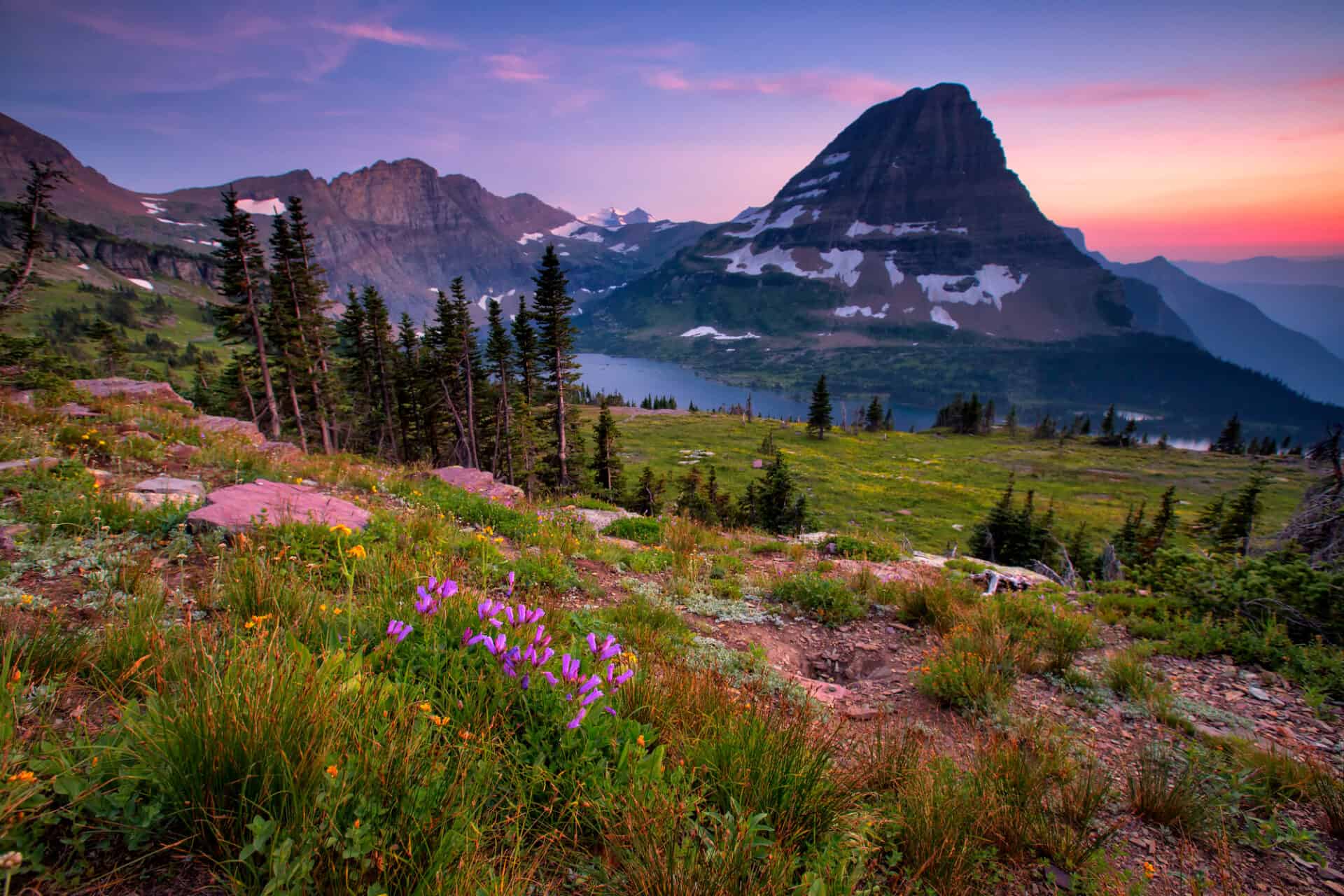The United States offers a multitude of breathtaking hiking destinations for outdoor enthusiasts. Here are some notable hiking tours across the country:
Grand Canyon National Park, Arizona:
Grand Canyon National Park offers a variety of hiking trails suitable for different skill levels and time constraints. Some popular trails include the Bright Angel Trail, South Kaibab Trail, North Kaibab Trail, and Rim-to-Rim Trail, providing stunning views of the canyon’s majestic landscape. You will witness towering cliffs, vast canyon panoramas, and unique rock formations. Permits are required for backcountry camping and overnight stays below the rim. It’s essential to plan well in advance and check the National Park Service website for permit availability and regulations. The dry desert climate, steep terrain, and extreme temperature fluctuations can pose challenges. As with any outdoor adventure, it’s crucial to follow the principles of Leave No Trace. Respect the environment, pack out your trash, and minimize your impact on the delicate desert ecosystem.
Yosemite National Park, California:
Trekking in Yosemite National Park, located in California’s Sierra Nevada mountains, offers breathtaking views, pristine wilderness, granite cliffs, waterfalls and ancient sequoia trees. Popular trails include the Mist Trail, Half Dome Trail, Yosemite Falls Trail, and the John Muir Trail (which passes through Yosemite). Yosemite has a permit system in place for some of the more popular hiking destinations and overnight camping. Permits are required for hikes like Half Dome and overnight stays in the park’s backcountry. Check the National Park Service website for permit availability and regulations, and plan accordingly. Wilderness camping is also available with a valid permit. Trekking in Yosemite allows you to immerse yourself in the stunning natural beauty and capture breathtaking views along the way. Yosemite is home to diverse wildlife, including black bears, deer, coyotes, and a variety of bird species. Keep a safe distance from wildlife, and follow park regulations regarding food storage. Additionally, you will encounter beautiful flora, including giant sequoias and diverse wildflowers. Guided tours provide insights into the park’s geology, ecology, and Native American heritage. Remember to practice Leave No Trace principles, respect the park’s rules, and preserve Yosemite’s wilderness for future generations.
Rocky Mountain National Park, Colorado:
Trekking in Rocky Mountain National Park, located in Colorado, offers scenic beauty and a vast wilderness with alpine lakes, majestic peaks, and diverse ecosystems. Some popular trails include the Bear Lake Loop, the Emerald Lake Trail, the Sky Pond Trail, and the Longs Peak Trail (a challenging summit hike). Trails in the park cater to both day hikes and multi-day backpacking trips. Backcountry camping permits are required for overnight stays in Rocky Mountain National Park. Obtain permits in advance, as they have a limited availability. Familiarize yourself with the park’s regulations, including camping restrictions, wildlife interactions, and fire regulations. Hiking through the park offers opportunities to witness panoramic vistas, encounter wildlife such as elk and bighorn sheep. Rocky Mountain National Park’s high altitude ranges from 7,500 feet (2,286 meters) to over 14,000 feet (4,267 meters). Summers offer pleasant temperatures for hiking, while winters are snowy and cold. Spring and fall can bring unpredictable weather, including sudden temperature changes and afternoon thunderstorms. Remember to follow Leave No Trace principles, respect wildlife, and preserve the park’s natural beauty.
Appalachian Trail:
The Appalachian Trail is a renowned long-distance hiking trail in the eastern United States, typically taking hikers 5 to 7 months to complete, a journey that promises unforgettable landscapes, personal growth, and a deep connection with nature. Spanning approximately 2,190 miles (3,524 kilometers), it stretches through 14 states, starting at Springer Mountain in Georgia and ending at Mount Katahdin in Maine. The Appalachian Trail offers mountains, forests, valleys, rivers and spectacular views along the way. No permits are required to hike the entire Appalachian Trail, although some sections may require permits for overnight camping. The trail passes through numerous towns along its route, providing opportunities for rest, resupply, and interaction with locals. The trail is lined with more than 250 backcountry shelters built for hikers’ use, typically spaced around 8 to 12 miles apart. These shelters are first-come, first-served and often include nearby water sources. Many hikers also opt for tent camping along the trail, adhering to Leave No Trace principles. To navigate the trail, hikers follow the iconic white blazes, which are approximately 2×6-inch white rectangles painted on trees, rocks, and posts along the path. These blazes guide you along the official trail and serve as trail markers. The Appalachian Trail has a unique hiking culture, fostering a sense of community among hikers. Many hikers adopt trail names and form friendships along the way. Participating in trail traditions, such as “trail magic” (unexpected acts of kindness from trail angels), adds to the sense of camaraderie.
Zion National Park, Utah:
Trekking in Zion National Park, located in southwestern Utah, offers a unique and stunning desert landscape with narrow slot canyons and diverse wildlife. From easy walks to challenging hikes, there’s something for everyone. Some popular trails include The Narrows, Angels Landing, Observation Point, Emerald Pools, and Hidden Canyon. Each trail offers its own distinct scenery and challenges. Permits are required for certain hikes in Zion National Park, such as The Narrows from the top down and overnight backcountry camping. It’s important to check the park’s website for permit availability, restrictions, and regulations. Spring and fall are popular times to visit due to milder temperatures and fewer crowds. However, flash floods are a potential risk in canyons. The towering sandstone cliffs, red rock formations, and the Virgin River running through the Zion Canyon create a breathtaking backdrop for your journey. The park’s unique slot canyons, like The Narrows, offer opportunities for thrilling and memorable experiences. As with any outdoor adventure, it’s essential to follow Leave No Trace principles to preserve the park’s natural beauty and protect its fragile ecosystems. Plan ahead, pack out your trash, and respect the park’s regulations to ensure the sustainability of this incredible place.

Glacier National Park, Montana:
A trekking adventure in Glacier National Park allows you to experience the rugged beauty of the northern Rockies and immerse yourself in one of America’s most scenic and untouched landscapes. Known as the Crown of the Continent, Glacier National Park in Montana offers stunning alpine scenery, glaciated peaks, pristine lakes, and abundant wildlife. Some popular trails include the Highline Trail, Grinnell Glacier Trail, Iceberg Lake Trail, Hidden Lake Trail, and the Ptarmigan Tunnel Trail. The iconic Going-to-the-Sun Road is a scenic drive that crosses the park and provides access to various trailheads and viewpoints. In Glacier National Park, no permits are required for day hikes. However, permits are needed for overnight backcountry camping and certain areas such as the North Circle and Belly River regions. Glacier National Park experiences a short summer hiking season due to its high elevation and mountainous terrain. The best time for hiking is typically from July to September when most trails are snow-free. Glacier National Park is home to a diverse range of wildlife, including bears (both black bears and grizzly bears, so familiarize yourself with bear safety practices), mountain goats and bighorn sheep. Don’t miss iconic spots like Lake McDonald, St. Mary Lake, Many Glacier Valley, and the spectacular Logan Pass. To preserve the natural beauty of Glacier National Park, it’s crucial to follow Leave No Trace principles. Respect the park’s regulations, pack out your trash, stay on designated trails, and minimize your impact on the environment.
Acadia National Park, Maine:
Trekking in Acadia National Park, located in Maine, offers a unique blend of rugged coastline, granite peaks, and diverse ecosystems. Acadia is the first place to see the sunrise in the U.S. Popular hiking trails include Jordan Pond Path, Precipice Trail, Cadillac Mountain South Ridge Trail, and the iconic Jordan Cliffs Trail. Each trail offers its own scenic beauty and unique terrain. One distinctive feature of Acadia National Park is its extensive network of carriage roads, which are ideal for walking, running, and biking. These beautifully maintained gravel roads wind through the park, providing access to various landmarks and offering a different perspective of the park’s landscapes. Summers are generally mild and pleasant, while winters can be cold with snow and ice. Spring and fall are popular times to visit due to milder temperatures and fewer crowds. No permits are required for day hiking in Acadia National Park. However, a park pass is necessary for entry, which can be purchased at park entrances or online. Acadia National Park’s rocky cliffs and ocean views provide a stunning backdrop for your trekking adventure. Don’t miss iconic spots like Cadillac Mountain, Thunder Hole, Sand Beach, and Schoodic Peninsula. The park also boasts beautiful lakes, such as Jordan Pond and Eagle Lake, which offer serene settings for a break or picnic. To preserve the natural beauty of Acadia National Park, it’s important to practice Leave No Trace principles. Pack out your trash, respect wildlife and vegetation, and minimize your impact on the environment. Stay on designated trails, as venturing off-trail can harm fragile ecosystems. By practicing responsible hiking, you help ensure the preservation of this remarkable national park.
Haleakalā National Park, Hawaii:
Trekking in Haleakalā National Park, located on the island of Maui, Hawaii, offers hikes through volcanic landscapes. Haleakalā National Park is known for its stunning volcanic summit, rising more than 10,000 feet (3,048 meters) above sea level. The park offers a variety of trails that showcase this otherworldly environment. The Haleakalā Summit Trail is a popular option, allowing you to hike within the crater and witness the surreal landscapes firsthand. Haleakalā is renowned for its spectacular sunrise and sunset views. Many visitors hike to the summit early in the morning or late in the day to experience the magical colors as the sun rises or sets. Beyond the summit, Haleakalā National Park includes extensive wilderness areas that offer unique trekking opportunities. The park has over 35 miles (56 kilometers) of trails, including the popular Pipiwai Trail in the Kīpahulu District. This trail leads through lush rainforests and past waterfalls, providing a contrast to the starkness of the summit. No permits are required for day hiking in Haleakalā National Park. If you plan to camp overnight and stay in the backcountry, you will need to obtain a wilderness camping permit. Practice Leave No Trace principles, and be aware of any regulations specific to the areas you plan to visit. Haleakalā National Park holds great cultural significance for Native Hawaiians. It is considered a sacred place, so it’s important to respect the park’s cultural heritage and follow any guidelines related to cultural practices or restrictions.
Olympic National Park, Washington:
Trekking in Olympic National Park, located in Washington State, offers a diverse and stunning wilderness experience with ancient forests, rugged coastline, alpine meadows, and glaciated peaks, and provides an opportunity to immerse yourself in the beauty of the Pacific Northwest’s natural landscapes. With its diverse ecosystems, Olympic National Park offers a range of hiking experiences. Popular trails include the Hoh River Trail, Hurricane Ridge Trail, Sol Duc Falls Loop, and the iconic Ozette Loop along the coastline. The park encompasses multiple wilderness areas, including the Hoh Rain Forest, Quinault Rain Forest, and the rugged coastline. Don’t miss the dramatic sea stacks along Rialto Beach or the serene beauty of Lake Crescent. Weather conditions in Olympic National Park can be highly variable, so it’s important to be prepared for changes in temperature, precipitation, and trail conditions. Permits are required for overnight camping in designated wilderness areas of Olympic National Park. Familiarize yourself with park regulations, such as food storage requirements and wildlife safety guidelines. Olympic National Park is home to diverse wildlife, including black bears, mountain goats, elk, and various bird species. Be aware of specific regulations for each camping area and practice Leave No Trace principles to minimize impact on the environment.
Great Smoky Mountains National Park, Tennessee/North Carolina:
Trekking in Great Smoky Mountains National Park, located on the border of Tennessee and North Carolina, offers a rich experience of diverse flora and fauna, and stunning mountain landscapes, and allows you to connect with the beauty of the Southern Appalachian Mountains. The Great Smoky Mountains provide a rich tapestry of lush forests, scenic waterfalls, and panoramic views, with a vast network of hiking trails, totaling over 800 miles (1,287 kilometers). You can choose from easy walks to challenging multi-day backpacking adventures. Some popular trails include the Alum Cave Trail to Mount LeConte, Charlies Bunion, Abrams Falls Trail, and the Appalachian Trail, which traverses the park. Don’t miss Clingmans Dome, the park’s highest point, offering panoramic views of the surrounding mountains. Other notable highlights include Cades Cove, a historic valley with abundant wildlife, the scenic Roaring Fork Motor Nature Trail, and the picturesque waterfalls throughout the park, such as Laurel Falls and Rainbow Falls. No permits are required for day hiking in Great Smoky Mountains National Park. However, if you plan to camp overnight in the backcountry, you will need to obtain a free backcountry camping permit. Familiarize yourself with park regulations, including food storage guidelines and appropriate fire use. Be cautious of potential wildlife encounters and maintain a safe distance. Great Smoky Mountains National Park has visitor centers located throughout the park, providing information, exhibits, and ranger-led programs. These programs offer insights into the park’s natural and cultural history and provide opportunities for guided hikes, wildlife viewing, and educational talks.
These are just a few examples of the many remarkable hiking destinations across the United States. Each destination has its unique charm, offering hikers a chance to explore diverse landscapes and immerse themselves in the natural beauty of the country.
This article is part of the series by Conscious Travel Guide, your resource for mindful globetrotting.


